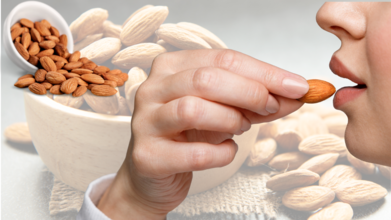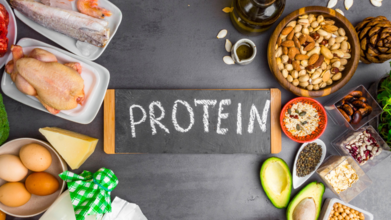- Health Conditions A-Z
- Health & Wellness
- Nutrition
- Fitness
- Health News
- Ayurveda
- Videos
- Medicine A-Z
- Parenting
- Web Stories
Healthy Food Swaps You Can Make For Sugary Choices Throughout Your Day

Image Credit: Canva
Everywhere you go, it's sugar-free this and sugar-free that. Sugar itself isn't the bad guy here; understanding the difference between natural and added sugars and making the right substitutions can set you up for success in this pursuit of a healthier lifestyle. In this feature, we talk about what sugar means to our diet and present how to convert some sugar-relished indulgence into energy- and nutrition-boosting alternatives.
Sugar is one of the types of carbohydrates. Carbohydrates are a macro-nutrient, but not like fiber or starch, are not strictly essential for a healthy diet. The natural sugars, like sucrose- common table sugar, fructose, and glucose, are present in fruits, vegetables, and dairy products. However, these sources of natural sugar also contain the important nutrients: fiber, antioxidants, and vitamins.
In contrast, added sugars-laden processed food and beverage contain virtually no nutrition and can cause problems ranging from obesity to type 2 diabetes, heart disease. Your body absorbs glucose, that is a molecule of glucose, to energize your body systems. Yet at the same time, added sugars in the diets can severely overwhelm the finely poised balance within an organism.
Why Healthy Food Swaps Make a Difference
Making small, consistent changes to your diet daily can significantly improve your long-term health. Healthy food swaps include substituting lower nutritional choices with healthier, more nutrient-dense alternatives. Such as substituting sugary sodas for sparkling water infused with a splash of fruit juice; not only is this cutting sugar, but it also contributes to hydration and a natural flavor.
Regardless of the reason-to lose weight, stabilize energy, or simply achieve healthier living-sugar swaps is one way to an easily achievable, long-term change.
Healthy Food Swaps to Reduce Sugar
Now take a more in-depth look at how easily you can begin making changes to your daily food habits:
1. Change Up Your Drinks
Craving the fizz of sugary sodas? Replace them with sparkling water that has a splash of fresh fruit juice or herbal teas. These options fulfill your desire for flavor without spiking your sugar intake.
2. Sweeten Desserts Naturally
Instead of piling sugary toppings onto desserts, try garnishing with chopped nuts, fresh fruits, or a dusting of cocoa powder. These additions enhance flavor and nutrition simultaneously.
3. Reinvent Your Morning Coffee or Tea
If you normally sweeten your hot beverages, think about adding a sprinkle of cinnamon, a splash of unsweetened almond milk, or even a dash of vanilla extract. These additions bring a flavor boost without added sugar.
4. Eat Smarter
Instead of grabbing for candy or cookies, choose naturally sweet snacks such as unsweetened dried fruits, dark chocolate with at least 70% cocoa, or fresh berries with Greek yogurt.
5. Refresh Your Dessert Habits
Instead of indulging in heavy desserts, complement your meal with a fruit platter. For added sweetness and digestive benefits, consider jaggery, a traditional sweetener packed with minerals like iron and potassium.
6. Healthify Your Baking
Replace white sugar with mashed bananas, unsweetened applesauce, or honey in your bakes. Such alternatives not only give moisture and nutrient-dense quality but also significantly reduce the glycemic load.
7. Get Savvy With Sauces and Dressings
Most of your commercial dressings, like ketchup and barbecue sauce, contain quite a lot of sugar. Do make homemade dressing with olive oil, balsamic vinegar, mustard, or avocado.
Should You Eliminate Sugar Completely?
It is quite appealing to cut sugar entirely out of one's diet. However, the negative impact might not be desirable. Natural sugars found in fruits, whole grains, and dairy products are great sources of energy and nutrients. If removed entirely, this may lead to deficiencies and symptoms like fatigue or brain fog.
Instead, they suggest cutting back on added sugars and artificial sweeteners. Ideally, one should strive for an approach that brings together whole, nutrient-dense foods and limited processed ones.
Easy Ways to Make Healthy Choices Every Day
Integrating these changes into your daily routine doesn’t have to be daunting. Start by identifying your high-sugar habits—such as sodas, dessert cravings, or processed snacks—and replace one item at a time with a healthier option.
- Prep your own meals and snacks to control ingredients.
- Stock your pantry with natural sweeteners and whole foods.
- Experiment with herbs and spices to enhance flavor naturally.
- Keep a stash of fresh fruits and unsweetened yogurt for quick treats.
Over time, these small shifts will become second nature, transforming your diet and supporting your health goals.
Adopting healthy food swaps doesn’t require drastic changes. Start with one or two small changes, like replacing soda with sparkling water or using fruits to sweeten desserts instead of sugar. Plan your meals and snacks in advance, focusing on whole, unprocessed foods. Keep healthy alternatives, such as nuts and dried fruits, on hand to curb cravings.
Gradually adjust your taste buds to appreciate natural sweetness. Celebrate your progress and remember, it's about balance, not perfection. These easy, consistent steps will help you cut down on added sugar easily while nurturing a healthier lifestyle.
How 60 Grams of Almonds Daily Protects DNA and Beats Stress: Study

Credits: Canva
For many, almonds are just that 4 pm snack when the stomach growls. But according to recent research published in The Journal of Nutrition, eating over 60 grams of almonds every day does a lot more than kill hunger pangs. It can actually protect your DNA and reduce oxidative stress, one of the invisible troublemakers behind ageing, inflammation, and disease.
The science behind almond power
Oxidative stress sounds complicated, but it is essentially what happens when your body is flooded with harmful free radicals, unstable molecules that damage cells and speed up ageing. Over time, this silent chaos chips away at your health, increasing your risk of chronic illnesses.
These nutrient-dense seeds are loaded with vitamin E, healthy fats, flavonoids, and antioxidants. Together, they form a cellular defence squad, fighting off free radicals and keeping your DNA intact.
As the study explains, people who ate over 60 grams of almonds daily experienced significant improvements in antioxidant status. This reduced key biomarkers of oxidative stress, which directly translated into healthier DNA and better-protected cells.
Building on earlier research
This is not the first time almonds have flexed their protective powers. A landmark randomised controlled trial tested 84 grams of almonds daily in young male smokers—arguably one of the toughest environments for oxidative damage. The results were striking: oxidative DNA damage dropped by about 28 per cent, lipid peroxidation (fat damage in the body) fell by 34 per cent, and DNA strand breaks decreased by 23 per cent. Even more impressively, antioxidant enzyme activity improved.
In other words, almonds worked even when the odds were stacked against them, laying the groundwork for current findings. The latest study reinforces that almonds are not just heart-healthy; they may actually slow down cellular wear and tear.
Why 60 grams daily is the magic number
You have probably heard health gurus praise almonds for brain function and heart protection, but this study sets a new benchmark. Sixty grams is not just a casual handful tossed into a trail mix. We are talking about 40 to 45 whole almonds, a deliberate daily serving.
At this intake, almonds hit what researchers call a “protective threshold”. The bioactive compounds reach levels strong enough to reduce DNA damage, combat lipid peroxidation, and boost antioxidant defences. Eating fewer almonds still has benefits, but the full protective effect seems to kick in once you cross that 60-gram line.
How to include 60 grams into your day
Sixty grams is roughly two servings, and with a little creativity, you can spread them throughout your day without it feeling like a chore.
- Snack smart: Keep a small container of raw or roasted almonds at your desk for mid-morning or late-afternoon cravings.
- Smoothie upgrade: Blend a handful of almonds or a spoonful of almond butter into your morning smoothie for creaminess and a nutrient boost.
- Breakfast crunch: Sprinkle chopped almonds over oatmeal, yoghurt, or cereal bowls.
- Lunch and dinner twist: Add slivered almonds to salads, curries, or stir-fries for crunch and texture.
- Spread the love: Swap your usual toast topping for almond butter, or use it as a dip with apple slices.
- Nutty mixes: Combine almonds with walnuts, cashews, and pumpkin seeds for a satisfying trail mix.
Beyond DNA: the bigger almond picture
Protecting your DNA might sound like something out of a sci-fi novel, but it is central to long-term health. When your cells are safeguarded from oxidative stress, your immune system works better, ageing slows down, and inflammation is kept in check. That means fewer wrinkles, stronger defences against disease, and an overall boost in energy and wellbeing.
And let us not forget the classic almond benefits: better heart health, improved cholesterol levels, enhanced brain function, and more stable blood sugar.
How Much Protein Is Too Much Protein?

Credits: Canva
Protein has earned a reputation as the building block of life, and for good reason. As one of the three essential macronutrients, alongside carbohydrates and fats, it plays a critical role in keeping your body functioning. From oxygen transport and immune defense to nerve signaling and tissue growth, protein is involved in nearly every system in your body.
But while it’s clear that protein is important, a question often comes up: Can you have too much of it? Let’s break down what the science says about protein requirements, and whether eating more than your daily share poses real risks.
How Much Protein Do You Really Need?
Your protein needs aren’t one-size-fits-all. They depend on several factors: your weight, age, physical activity, body composition goals, and overall health status.
The Recommended Dietary Allowance (RDA) for the average adult is 0.36 grams per pound (0.8 grams per kilogram) of body weight. This amount is generally enough to meet basic nutritional needs for most sedentary adults.
However, experts suggest that people who are physically active often need more, anywhere from 0.54 to 0.9 grams per pound (1.2–2 grams per kilogram) per day. Athletes may even require higher amounts to support muscle repair and performance.
Certain groups, such as pregnant or breastfeeding individuals, older adults, and people recovering from illness or injury, also have increased protein needs. For example, during pregnancy, the recommendation rises to about 0.5 grams per pound (1.1 grams per kilogram).
Are High-Protein Diets Harmful?
For years, concerns have circulated about the safety of high-protein diets, particularly regarding their potential impact on the kidneys, heart, and bones. But research suggests that many of these fears are unfounded — at least for healthy individuals.
Heart Health
Some worry that consuming too much protein, especially from animal sources, might raise the risk of heart disease. However, large-scale studies have not found a consistent link. One study involving over 12,000 adults found no association between animal or plant protein intake and heart disease risk. Similarly, reviews in 2020 and 2023 concluded that high protein intake was not connected to increased risks of stroke, cardiovascular death, or other heart-related conditions.
Bone Health
Earlier research hinted that high-protein diets might weaken bones by increasing calcium loss. Yet more recent evidence shows the opposite. A 2019 review of 13 studies found that higher protein intake — above the current RDA, was linked to stronger bones and a reduced risk of hip fractures. Since protein makes up over one-third of bone mass, adequate intake, alongside calcium and vitamin D, supports skeletal health.
If you’re thinking about ramping up your protein intake, the key is balance and individualization. While high-protein diets appear safe for most healthy people, your exact needs depend on your lifestyle, age, and health conditions.
Working with a registered dietitian or qualified healthcare provider can help you find the right amount for your body while ensuring your diet stays balanced with other nutrients. After all, protein is powerful, but it works best as part of a well-rounded eating plan.
Celebrity Nutritionist Shares 5 Signs Of Poor Diet

Credits: Canva
If you think “healthy eating” is just about protein shakes, cutting carbs, and stocking your fridge with probiotic shots, celebrity nutritionist Rujuta Diwekar wants to have a word with you. Known for guiding Bollywood’s biggest names, including Kareena Kapoor, Rujuta is famous for her practical, grandma-approved advice. In her August 11 Instagram post, she listed five signs your diet is not only unsustainable but also joyless. And her antidote is simple: good old home-cooked food.
1. Protein Overload
While protein is important, your diet should not look like a bodybuilding competition menu. You might do more harm than good. Rujuta warns that loading up on a single nutrient creates imbalance both on your plate and in your gut. If dal, sabzi, roti, and a bit of rice have been replaced with chicken breasts and protein bars, you are not nourishing yourself; you are overdoing it.
2. No Spice, No Fun
Somewhere along the way, you ditched your daily pickle, chutney, or masala because someone on the internet said, “Seasonings cause water retention.” Now, your evenings are spent rummaging through cupboards looking for anything salty, spicy, or sweet to kill the craving. Rujuta’s point is that flavour is not the enemy. A little tadka in your dal or a sprinkle of chaat masala on your salad can actually make your meals more satisfying and keep late-night snack attacks at bay.
3. Portion Panic
You start cutting back on roti. Then you take only half a spoon of rice. Next thing you know, you are eying your own fruit bowl suspiciously. This “portion paranoia” often does the opposite of what you intended: it strips meals of comfort and turns eating into a stress sport. Rujuta reminds us that eating enough is essential, not indulgent. Confidence does not come from calorie counting; it comes from nourishing your body so it works with you, not against you.
4. Festivals Feel Like Cheating
If modak during Ganpati, sheer korma on Eid, or Christmas cake feels like a guilty transgression, your diet is robbing you of more than calories; it is stealing your joy. Food is culture, connection, and celebration. The minute your “diet plan” turns family gatherings into anxiety traps, it is no longer healthy. Rujuta says that food is culture, community, and cuisine. It is a wholesome way to live.
5. Gut Health Overload
Once upon a time, a happy stomach meant you ate on time and enjoyed your meals. Now, you have got a probiotic drink, a prebiotic pill, and some digestive tonic, yet your gut feels perpetually off.Ironically, over-focusing on “gut health” can stress your digestive system further. Sometimes, what your stomach really needs is not a lab-formulated elixir but a home-cooked khichdi and curd.
Why Home-Cooked Food Wins Every Time
Rujuta’s core philosophy is deceptively simple: eat what you can make at home, using local, seasonal ingredients, without obsessing over macros and metrics.Why? Because home-cooked food naturally ticks all the boxes; it is balanced, economical, and emotionally grounding. It does not just help you lose weight; it helps you stop making weight loss the centre of your life.
A plate of fresh roti, ghee-topped dal, sabzi, and a little pickle is not just dinner; it is tradition, nutrition, and comfort, all in one. Plus, it is far cheaper than imported almond flour or cold-pressed mushroom juice.
Rujuta’s five red flags are a reminder that eating well should add to your life, not shrink it down to a list of forbidden foods.
© 2024 Bennett, Coleman & Company Limited

